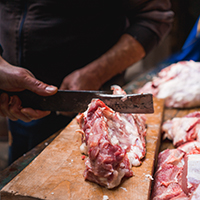Knowledge of occupational hazards, and safety practices among butchers in Kano metropolis, Kano State, Nigeria

Submitted: 5 February 2019
Accepted: 10 July 2019
Published: 19 February 2020
Accepted: 10 July 2019
Abstract Views: 1093
PDF: 535
Publisher's note
All claims expressed in this article are solely those of the authors and do not necessarily represent those of their affiliated organizations, or those of the publisher, the editors and the reviewers. Any product that may be evaluated in this article or claim that may be made by its manufacturer is not guaranteed or endorsed by the publisher.
All claims expressed in this article are solely those of the authors and do not necessarily represent those of their affiliated organizations, or those of the publisher, the editors and the reviewers. Any product that may be evaluated in this article or claim that may be made by its manufacturer is not guaranteed or endorsed by the publisher.

 https://doi.org/10.4081/pjm.2019.41
https://doi.org/10.4081/pjm.2019.41



